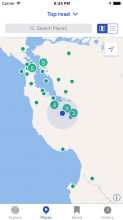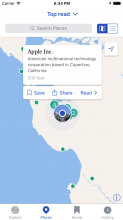Including Apple Maps in our app is not, in my honest opinion, a good thing.
Since our mission is to deliver freely licensed material, so should the app. For instance, no screenshot of the app with the map could ever be uploaded to Commons, since the map is fully copyrighted to Apple.
While it may be legal for us to use Apple Maps, it still is not freely licensed, and therefore, I believe, against our mission. Please, replace Apple Maps (a proprietary software) and use any freely licensed map instead.
Details at https://www.mediawiki.org/wiki/Wikimedia_Apps/Team/iOS/Maps_service.

